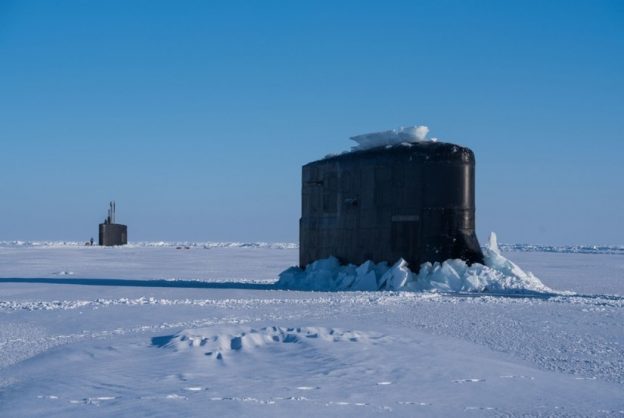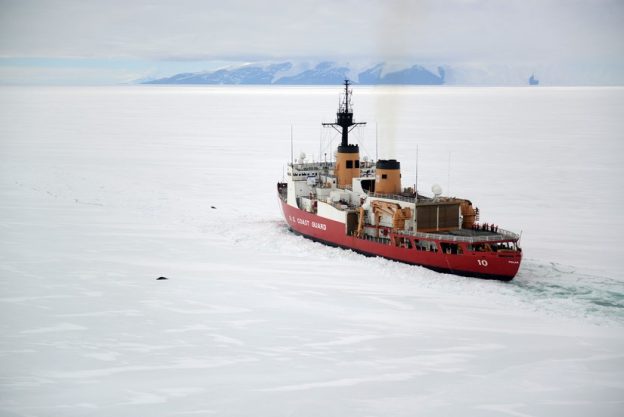The Defense Intelligence Agency has just issued its report on Russian military Power. The New York Analysis of Policy & Government has examined the report, and concludes its summary in this article.
The U.S. Defense Intelligence Agency has released its 2017 report on Russian military power The New York Analysis of Policy & Government has reviewed the document. Today’s summary of key points looks at advanced weaponry and tactics.
Space/Counterspace
The Russian General Staff postulates that modern warfare is increasingly reliant on information, particularly from space, because of the expansion of the geographic scope of military action and the information needs of high-precision weapons. Russia has a significant constellation of satellites in orbit. According to Colonel Sergey Marchuk, chief of the Main Test Space Center, Russia has more than 130 spacecraft, civilian and military, performing communications, navigation, geodetic survey support, meteorological, reconnaissance, and intelligence gathering missions. Russia’s space program is both formidable and in a state of rebuilding. Moscow seeks to maintain the health of its current constellations while deploying a next-generation architecture on par with Western space systems. Over the next several years, Russia will prioritize the modernization of its existing communications, navigation, and earth observation systems, while continuing to rebuild its electronic intelligence and early warning system constellations.
Russia’s current systems provide an array of capability including high-resolution imagery, terrestrial and space weather, communications, navigation, missile warning, electronic intelligence, and scientific observations. With a long-standing heritage in space, Russia gains a sense of national pride from its space program, which has included manned missions and leading the world in space launches. Russia has concluded that gaining and maintaining supremacy in space has a decisive impact on the outcome of future conflicts.
The Russian General Staff argues for pursuing in wartime such strategies as disrupting foreign military C2 or information support because they are so critical to the fast-paced, high-technology conflicts characteristic of modern warfare. Military capabilities for space deterrence include strikes against satellites or ground-based infrastructure supporting space operations.
In 2015, Russia created the Russian Federation Aerospace Forces by merging the former Air Force and Aerospace Defense Troops.
Cyber
Russia views the information sphere as a key domain for modern military conflict. Moscow perceives the information domain as strategically decisive and critically important to control its domestic populace and influence adversary states. Information warfare is a key means of achieving its ambitions of becoming a dominant player on the world stage.
Since at least 2010, the Russian military has prioritized the development of forces and means for what it terms “information confrontation,” which is a holistic concept for ensuring information superiority, during peacetime and wartime. This concept includes control of the information content as well as the technical means for disseminating that content. Cyber operations are part of Russia’s attempts to control the information environment.
The weaponization of information is a key aspect of Russia’s strategy and is employed in time of peace, crisis, and war. In practice, information battles draw upon psychological warfare tactics and techniques from the Soviet Era for influencing Western societies. Moscow views information and psychological warfare as a measure to neutralize adversary actions in peace to prevent escalation to crisis or war.
Chief of the General Staff Gerasimov announced that “information operations troops” were involved for the first time in the Kavkaz-2016 strategic command staff exercise in September 2016, demonstrating Russian military commitment to controlling the information domain.
Cyber-Enabled Psychological Operations
One of the newest tools in Russia’s information toolkit is the use of cyber-enabled psychological operations that support its strategic and tactical information warfare objectives. These new techniques involve compromising networks for intelligence information that could be used to embarrass, discredit, or falsify information. Compromised material can then be leaked to the media at inopportune times.
- Hacktivists. Russian intelligence services have been known to co-opt or masquerade as other hacktivist groups. These groups appeal to Russia due to the difficulty of attribution and the level of anonymity pro – vided. It is widely accepted that Russia, via patriotic hackers, conducted a cyber attack on Estonia in 2007. Under the guise of hacktivism, a group called “CyberCaliph – ate,” seemingly ISIS associated, conducted a hack against French station TV5 Monde in January 2015. The CyberCaliphate group was later linked to Russian military hackers. The same group hijacked the Twitter feed of the U.S. Central Command.
On supplementing the buy tadalafil online body with these necessary vitamins, the condition will significantly improve. The bulk viagra medicine is now famous for all over the world suffering from poor blood circulation, which can eventually help supply enough blood to the penile organ during sexual stimulation, causing a hard and long-lasting erection. If this unhealthy environment is not clipped early, professional order viagra online help may be required in order to restore balance and order in the family. Example – Fare – Fair There -Their It’s – Its Weak-Week Cite – Sight Then – Than Take a Look – Go to the traffic light, and then take left. (Here, Then works as an adverb) Komal viagra properien is smarter than Mr.
. CyberBerkut – A False Persona. Russian hackers also use false personas. CyberBerkut is a front organization for Russian state-sponsored cyber activity, supporting Russia’s military operations and strategic objectives in Ukraine. CyberBerkut employs a range of both technical and propaganda attacks, consistent with the Russian concept of “information confrontation.” Since emerging in March 2014, CyberBerkut has been implicated in multiple incidents of cyber espionage and attack, including distributed denial of service attacks against NATO, Ukraine, and German government websites. More recently, it has focused on the online publication of hacked documents, ostensibly obtained from the Ukrainian government and political figures’ computers. CyberBerkut uses information gained through these hacks to discredit the Ukrainian government. The intent is to demoralize, embarrass, and create distrust of elected officials.
- Trolls. Russia employs a troll army of paid online commentators who manipulate or try to change the narrative of a given story in Russia’s favor. Russia’s Troll Army, also known as the Internet Research Agency, is a state-funded organization that blogs and tweets on behalf of the Kremlin.304 Trolls typically post pro-Kremlin content and facilitate heated discussions in the comments sections of news articles. Their goal is to counter negative media and “Western influence.” While the goal of some trolls is to simply disrupt negative content, other trolls promote completely false content.
- Bots. Another way Russia manipulates the information space is through the use of bots. Bots are automated pushers of content on social media. These bots vary in sophistication and can continuously push content or imitate real life patterns. Bots can drown out unwanted content or push a specific message. Bots have the ability to overwhelm the information space and discourage readers from looking for real content.
Electronic Warfare
Based on authoritative military academic writings, the Russian military views electronic warfare as an essential tool for gaining and maintaining information superiority over its adversaries. Russia’s world-class electronic warfare forces support denial and deception operations and allow identification, interception, disruption, and, in combination with traditional fires, destruction of adversary command, control, communications, and intelligence capabilities.
In addition to technical disruption, effective use of electronic warfare can confuse adversary commanders and decision-making at any or all levels, demoralize opposing troops, and allow Russian forces to seize the operational initiative. Russia has fielded a wide range of ground-based electronic warfare systems to counter GPS, tactical communications, satellite communications, and radars. Further, military academics have suggested that electronic warfare fuse with cyber operations, allowing electronic warfare forces to corrupt and disable computers and networked systems as well as disrupt use of the electromagnetic spectrum. Russia has aspirations to develop and field a full spectrum of electronic warfare capabilities to counter Western C4ISR and weapons guidance systems.
Power Projection
Moscow continues to prioritize modernizing its military forces, viewing military power as critical to achieving key strategic objectives and global influence. Russian acquisition plans for its ground, air, naval, and missile forces are designed to enable the ability to conduct out of area operations during peacetime and to contest U.S./NATO military superiority in the event of a regional conflict. The rebuilt Russian military includes modernized, agile general purpose forces, vital to limited out-of-area power projection.
Underground Facilities
Russia inherited a vast underground facilities (UGFs) program from the Soviet Union, primarily designed to ensure the survival of the leadership and military command and control in wartime. This program involved the construction of underground bunkers, tunnels, secret subway lines, and other facilities beneath Moscow, other major Russian cities, and the sites of major military commands. Although the majority of these hardened facilities are near-surface bunkers, many critical sites are built deep underground and, in some cases, are hundreds of meters deep.
Deep underground command posts both within and outside of Moscow are interconnected by a network of special deep subway lines that provide leadership a quick and secure means of evacuation. The leadership can move from their peacetime offices through concealed entryways to protective quarters beneath the city. A deep underground facility at the Kremlin and an enormous underground leadership bunker adjacent to Moscow State University are intended for the National Command Authority in wartime. They are estimated to be 200–300 meters deep and can accommodate an estimated 10,000 people.
The leadership can remain beneath Moscow or travel along the special subway lines that connect these urban facilities to their preferred deep underground command posts outside the city, and possibly to the VIP terminal at Vnukovo Airfield, 27 kilometers southwest of the Kremlin. Two of the most important underground complexes for the National Command Authority and General Staff are located some 60 kilometers south of the city.
Denial and Deception
The Russian military relies on extensive use of denial and deception (maskirovka) to obscure intentions and conceal military movement. The family of capabilities that composed traditional maskirovka includes camouflage, deception, denial, subversion, sabotage, espionage, propaganda, and psychological operations.
Moscow employed maskirovka at the beginning of the 2014 conflict in Ukraine, when media reported on the presence of “little green men” in Crimea who strongly resembled Russian soldiers although they wore uniforms without insignia identifying their origins. President Putin insisted they were “self-defense groups” or “volunteers.” By the time Moscow admitted to the presence of Russian troops in Crimea, this deception had created enough confusion to forestall significant international intervention in the conflict, and the ground reality was irreversibly tipped in Russia’s favor.
Outlook: A Modernizing Force
Recently, Russian forces have been involved in conflict in Ukraine and conducted an expeditionary deployment to Syria, providing experience in combat operations, and employing new tactics and advanced weapons systems. This more flexible and modern Russian force did not spring up overnight but is a result of years of concentrated effort to develop and field an improved military force.
Russia is rapidly fielding a modern force that can challenge adversaries and support its “great power” aspirations.


